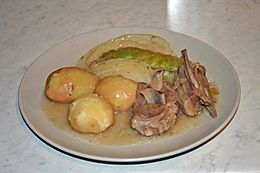Fårikål facts for kids
 |
|
| Type | Stew |
|---|---|
| Place of origin | Norway |
| Region or state | Norway |
| Main ingredients | Mutton with bone, cabbage, black pepper, wheat flour |
Fårikål is a super popular and traditional dish from Norway. Many people even call it Norway's national dish! It's a warm and hearty stew, perfect for chilly days.
This tasty meal is made with pieces of mutton (which is meat from a grown-up sheep) that still have the bone in them. It's cooked slowly with cabbage, whole black pepper grains, and sometimes a little bit of wheat flour. Everything simmers together for several hours in a big pot. When it's ready, it's usually served with potatoes that have been boiled in their skins. People often make Fårikål in the early autumn.
There's even a special day for it! The Fårikål Feast Day is celebrated every year on the last Thursday in September.
Contents
What Does Fårikål Mean?
The name Fårikål is actually quite simple to understand. It's a combination of two Norwegian words: "får" which means "mutton" (or sheep meat), and "i kål" which means "in cabbage." So, Fårikål literally means "mutton in cabbage."
The name was inspired by an old Danish dish called "gaas i hvidkaal," which meant "goose in white cabbage."
Fårikål in the Spotlight
Fårikål has been part of some exciting events and decisions in Norway!
Setting a World Record
On September 29, 2012, Fårikål made it into the Guinness World Records! A huge team cooked the largest portion of Fårikål ever made. It weighed an amazing 594.2 kilograms (that's over 1,300 pounds!). This giant stew was made with 60% lamb (meat from a young sheep) and 40% cabbage.
This record-breaking event happened in a place called Spikersuppa in Oslo, the capital city of Norway. About 10,000 guests were there to see and enjoy the massive meal!
Norway's National Dish
Back in the 1970s, Fårikål was chosen as the national dish of Norway. This happened because of a popular radio show called Nitimen.
Then, in 2014, there was a bit of a discussion about whether Fårikål should still be the national dish. The food and agriculture minister at the time, Sylvi Listhaug, decided to hold a new competition to pick a national dish. But guess what? After all the debate, Fårikål was chosen again and reconfirmed as Norway's national dish!
See also
 In Spanish: Fårikål para niños
In Spanish: Fårikål para niños

